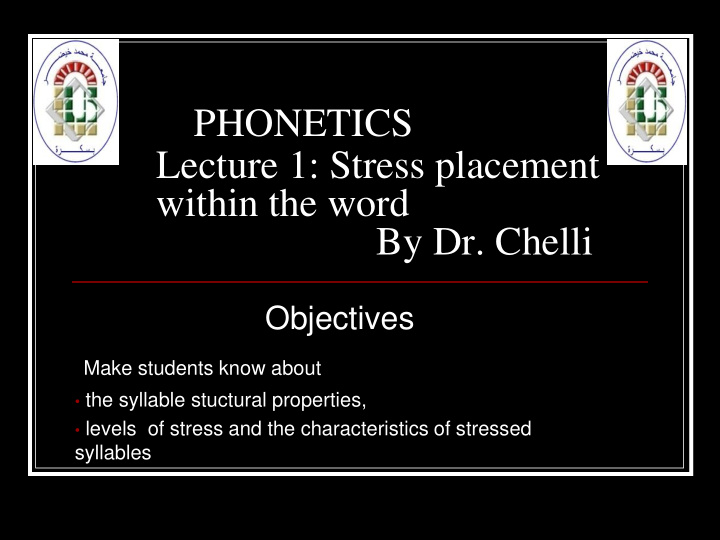



PHONETICS Lecture 1: Stress placement within the word By Dr. Chelli Objectives Make students know about • the syllable stuctural properties, • levels of stress and the characteristics of stressed syllables
Can you define the term „syllable‟?
1. Definition of syllable A syllable is a single unit of speech which contains, most of the time, a vowel.
2. Syllable structural properties If we have a look at the structural properties of the syllables, we can notice that each syllable consists of a nucleus (central peak of sonority), usually a vowel, and the consonants that cluster before and after the nucleus are called the onset and the coda respectively.
Syllable parts Description Optional Onset Initial segment optional of a syllable Nucleus Central segment obligatory of a syllable (core) Coda Closing optional segment of a syllable
The preceding consonants or consonant cluster before the nucleus are called the “ onset ”. - The consonants or consonant cluster following the nucleus are called the “ coda ”. An English syllable requires a nucleus which is a vowel in most cases, although the consonants [ r ̩ ], [ l̩ ], [ m ̩ ], [ n ̩ ] can be also the nucleus of a syllable (syllabic)
Zero onset: if the syllable does not contain any consonant before the vowel. E.g.: I’ll, On, Ask Zero coda: when the syllable has no consonant after the vowel. E.g.: May, Fee, Strew, Troy
A syllable that stands alone is called monosyllabic, e.g., horse, train, wide, show… A word containing more than one syllable is called polysyllabic, e.g., carry, deliver, organize, transformation, unwillingly, undoubtedly…
How does a listener perceives stress? What about the speaker?
The listener perceives stress syllable as loud While the speaker furnishes effort in its articualtion
The accented pattern of English word may be considered as fixed b ecause the stress falls on the same syllable in a given word but it may be considered as free because it may fall on the first, second, third or last syllable in a given word Look at these words. What do you notice? wa ter / ˈ w ɔ:tə / to ge ther /t əˈ ge ðə/ infor ma tion / , ɪnfəˈ m eɪʃn/ Volunteer / ,vɒlənˈtɪə
Levels of stress There are two levels of stress: primary stress and secondary stress. A third level refers to unstressed syllables. Example, in the verb organize there are two levels / ˈɔ: g ən a ɪz/. Can you identify them? In the word organization, there are three levels / ̗ɔ: g ən a ɪˈzeɪ ʃn/
5. Characteristics of stressed syllables Pitch : it is the most efficient factor for recognizing the prominence of stressed syllable, in which the stressed syllable is pronounced with a higher pitch than unstressed ones. Energy of articulation (loudness): the stressed syllables seem to be louder to the listener‟s ear than unstressed ones. Quantity/ Duration (length ): stressed syllables are longer than unstressed ones and take more time to be pronounced than the vowels of the unstressed syllables, which are reduced in length. Quality: the stressed syllable mostly has strong vowels / e , æ , ɒ , ɑː , iː , ɔː , ɜː , əʊ , a ɪ, a ʊ/ whereas the weak vowels such as /ə, ɪ, ʊ/ are most of the time unstressed in polysyllablic words.
In order to decide about stress placement, it is necessary to make use of some or all of the following: Whether the word is morphologically simple or complex (containing one or more affixes, or being a compound word) The grammatical category to which the word belongs (noun, adjective, verb, adverb…) The number of syllables in the word The phonological structure of the syllable
Recommend
More recommend